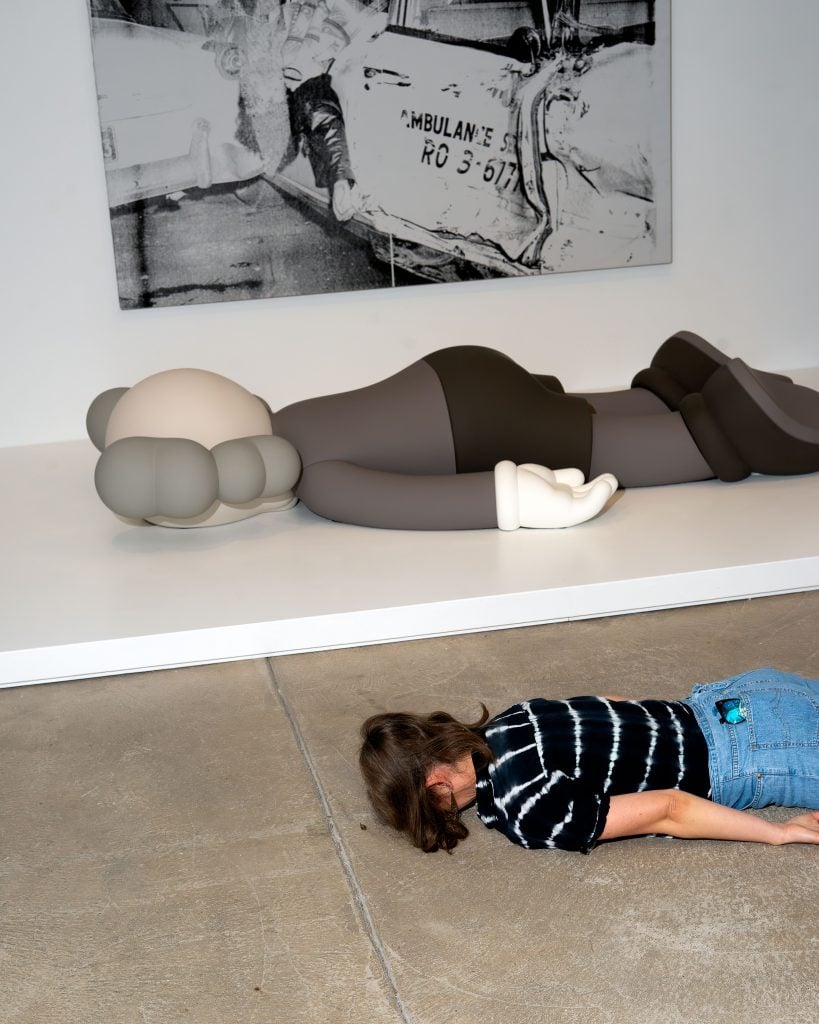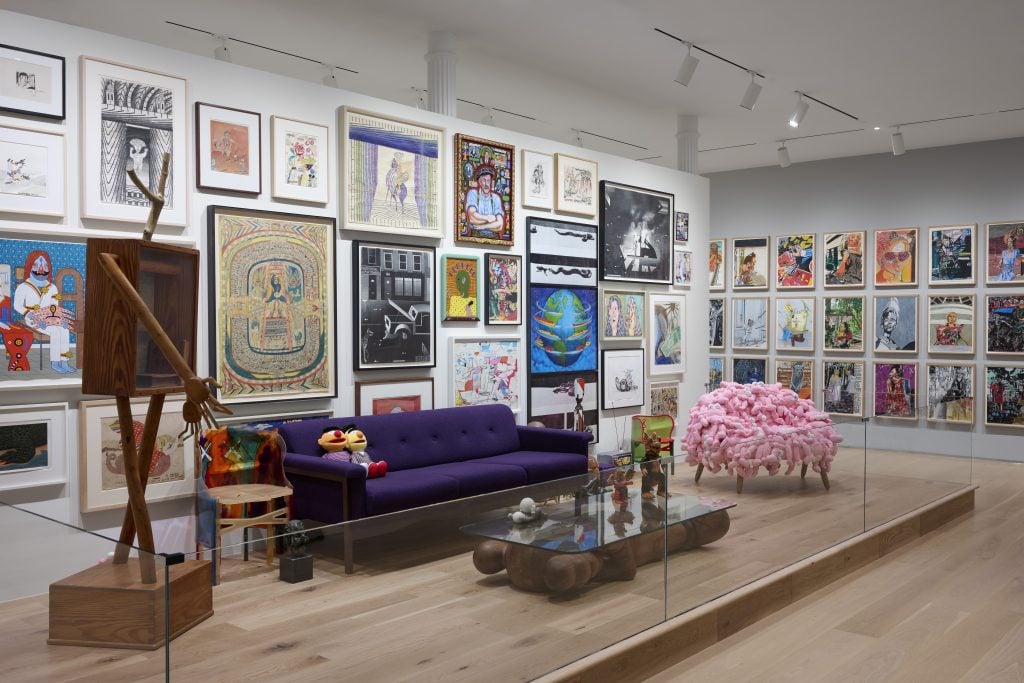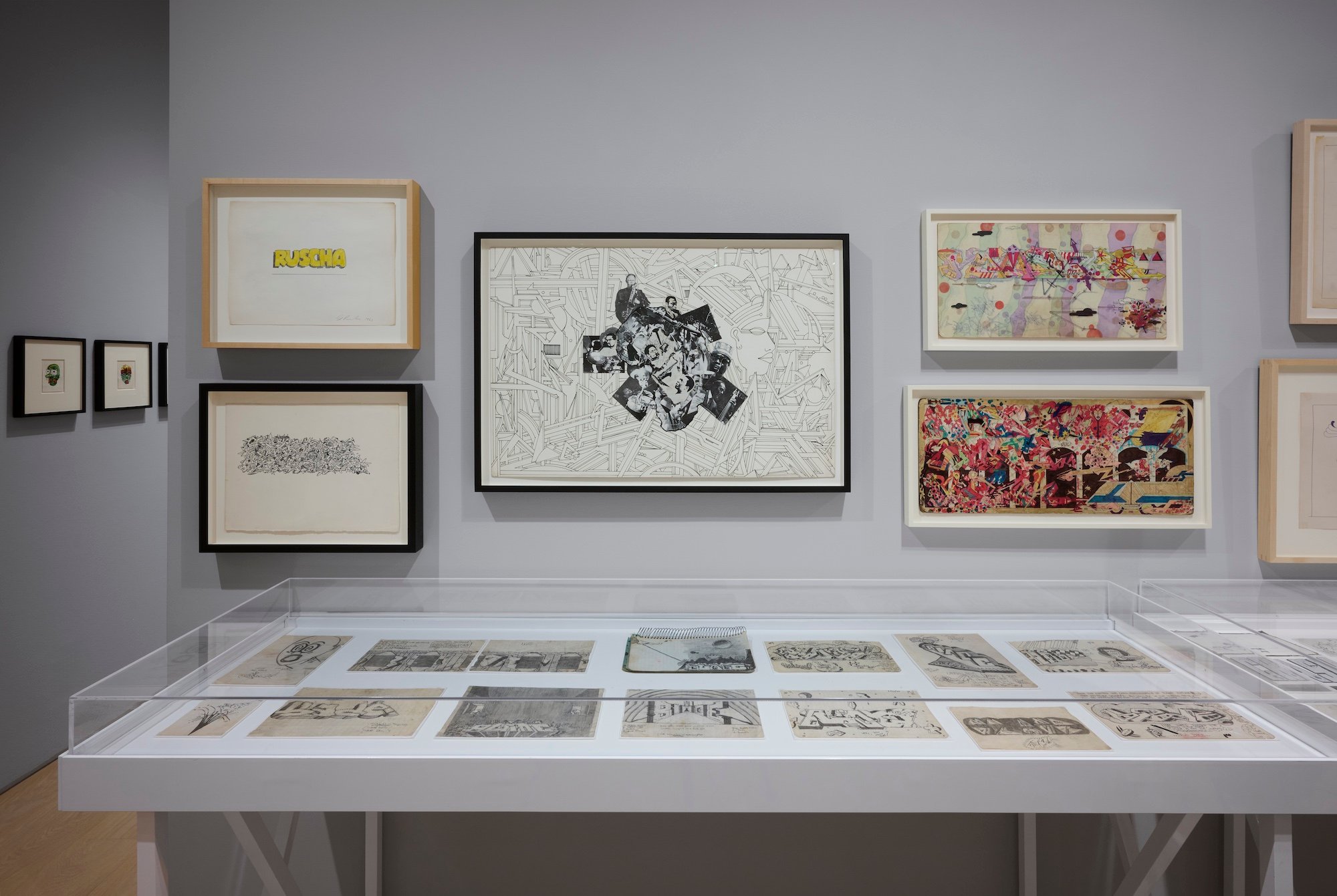Opinion
This Thrilling New Show Will Change the Way You Think About KAWS
The multifarious artist's new exhibition at the Drawing Center in New York champions a remarkable variety of figures.

Why does the art world begrudge the fact that KAWS is one of the biggest names in town? There is an art-world cabal that fascinates me, consisting of those who think it looks smart to wrinkle one’s nose at the mere glimpse of a work by him. We all recognize that he’s sold more than any number of equivalent art stars put together and enjoys global commercial appeal. Yet, despite this popularity, wherever I go, the broader art consensus is against him.
The way I see it, it’s all about money, and how KAWS makes it. Despite the fact that many artists we know have reproduced the same idea ad nauseam and cashed in on the market mania of the past 10 years, the art world is uncomfortable with KAWS as a brand and as a business. He has launched endless figurines, plush dolls, T-shirts, and sneakers, and they have sold so well that he can co-brand with the likes of Dior, Uniqlo, and A Bathing Ape. His fans include rappers, celebrities, and multi-hyphenates like Pharrell Williams. In certain ways, Brian Donnelly is not unlike Damien Hirst, having achieved the Warholian dream of crossing over from the art world into the public consciousness, the real world.
But KAWS came from the outside, broke in, and then broke back out, far beyond the often-sterile walls of the gallery and museum system, to a degree that not even Hirst has achieved. Sure, you can say that Richard Prince made Louis Vuitton bags, and that Takashi Murakami kicked off this trend, thanks to Marc Jacobs, but my daughter’s room is filled with KAWS figures and prints, like many 15-year-olds’ around the world. That’s unique. His merch, his sculptures, and his paintings offer something for literally everyone, and I know for certain that that violates one of the foundational rules of the art world.
The art industry’s gatekeepers guard their fragile velvet ropes intensely, and they relish the opportunity to snub anything that reeks of open commerce. Perhaps in private moments they are also a little embarrassed (and jealous?) that KAWS has succeeded so masterfully in his full embrace of art as business in a way that they have not. It does make you stop and wonder how he pulled it off, and how he continues to do so.

Installation View of “The Way I See It: Selections from the KAWS Collection” at the Drawing
Center in New York, October 10, 2024–January 19, 2025. Photo: Jason Schmidt
“The Way I See It: Selections from the KAWS Collection,” which he just organized at the Drawing Center in New York, serves as a guide to his way of seeing art while at the same time placing himself in a history and context that supports his artistic vision. Brian’s long felt the cold shoulder of being an outsider, so here’s a collection of “outsiders”—amazing outsiders, in some cases—who prove that art-world hierarchies are often myopic and seriously flawed.
I won’t bore you with my personal likes, but let’s have a look at who’s here. (And full disclosure: Some of the artists have been exhibited by my gallery, Venus Over Manhattan, like H.C. Westermann, Peter Saul, Yuichiro Ukai, and Ana Benaroya.) Joe Coleman is a standout, a great painter and total eccentric who depicts criminals and freaks with such incredible detail and precision that it’s maddening. He most often can be seen in the wonderful Outsider Art Fair or at the American Folk Art Museum in New York, so there’s no way he’s getting legitimized by the establishment anytime soon. Or take R. Crumb: Though David Zwirner shows him, he’s still a master on the margin, half in and half out. He can never escape the fact that he created Zap Comix, a legendary underground comic series, and thus he never gets the respect of, say, Raymond Pettibon, another countercultural draughtsman who shows with Zwirner.
Peter Saul has been championed by KAWS, and he’s another good case. He’s certainly no “self-taught” painter, nor an outsider, since he’s represented in every major museum in America and in many abroad, too. But so often he’s treated like some kind of outsider since the work is always on the edge of épater le bourgeois, by design. Saul never sought fame or fortune. He created his own story and art narrative, in total disregard of fashion and market pressures. His art skills are exemplary, and he’s still working at 90.
How about the great American hero H.C. Westermann, a master draughtsman and master sculptor who never quite fit the gallery mold? Perhaps after surviving as a marine in World War II and then fighting in Korea, he just couldn’t be bothered to deal with the still-greater stress of managing a legacy in the art market.

Installation View of “The Way I See It: Selections from the KAWS Collection” at the Drawing
Center in New York, October 10, 2024–January 19, 2025. Photo: Jason Schmidt
Brian has also gone deep on some “self-taught” lodestars like Henry Darger and Martín Ramírez. These are his “folk art roots,” where outsiders are respected and included along with household names like Ed Ruscha, George Condo, Willem de Kooning, and Mike Kelley, as well as newly minted blue chips like Nicole Eisenman and Dana Schutz. What brings them all together now? Figuration and its evolution. This show is not flexing any abstract painterly fantasies.
And let us not forget the Chicago Imagists’ place in the KAWS tabernacle. Like him, these “Hairy Who” artists brought “low” culture to the highbrow world of art. In the 1960s, Jim Nutt, Gladys Nilsson, Karl Wirsum disregarded the East Coast’s stiff rules of art (look no further than the name they adopted), and drew distorted, shocking, and uninhibited images, using exacting lines to render occasionally grotesque visions.
When you think of collecting Peter Saul or George Condo as it relates to KAWS, you are led to the well of figuration. These artists in the collection have developed their unique voices by virtue of the lines they draw: precise, balanced, rhythmic, and unique. Brian is telling us to see his art in the same way, with his precise lines, his super-refined painting skills, and his portraiture, which always leaves us with an open question.
Interestingly, KAWS is loyal to some vintage graffiti masters, and the ones he owns mostly pre-date him significantly. We see here some excellent work by Lee Quiñones, Rammellzee, Phase 2, Dondi, and Futura 2000. (Go look for them at your favorite museum!)
Now, why did Laura Hoptman, the Drawing Center’s director, do this? On its face, it’s somewhat surprising, given KAWS’s reputation in the art world. But consider what the Center has done to help “rediscover” the likes of Frank Walter, Stephane Mandelbaum, and Naudine Pierre. Laura has the funding and the gumption to keep it historic, allow for the esoteric, and challenge the status quo: institutional shows of known artists that get rehashed, reheated, and rehung.

Installation View of “The Way I See It: Selections from the KAWS Collection” at the Drawing Center in New York, October 10, 2024–January 19, 2025. Photo: Jason Schmidt
How about that excellent, if somewhat musty, show the Drawing Center did of Jack Shear’s beautiful collection? Jack was the life partner of Ellsworth Kelly, and took an interesting approach to historic and more recent works on paper, delivering a compelling show by an art world insider of a bygone era. This is where KAWS fits in. His eclectic collecting has become part of his work. Still, I can’t forget the time I once tried to put him in a group show and the curator threatened to quit! Why do they frown upon him and his work so vehemently? That onion is fun to peel, and this show makes clear what they are missing.
At the end of her catalog essay, Hoptman quotes art historian Thomas Crow saying that the collection “adds up to a persuasively alternative history of recent art that supplants the faltering textbook versions still holding sway over young artists.” That sway still grips collectors, I might add! Who needs to see another cookie-cutter collection of pricy blue chips or consensus-approved newbies? Definitely not me! Zzzz. In his collecting, KAWS has created an art universe in which he fits perfectly. He has given himself a context that explains his artistic contribution and why the art world should take him seriously.
“The Way I See It” offers refreshing and challenging insights into an artist’s vision. This is an extremely precise and thoughtful look at artists that eschew the standard rankings, which are determined by money, exclusivity, and museum and collector buy-in.
KAWS universe of “great artists” reveals that he knows what’s been anointed by the establishment, but that he refuses to bow to it. He embraces the self-taught, overlooked, and under-appreciated, and makes us look afresh at his own work. This show is a must-see for those interested in an expanded vision of the art world that questions who defines it and how. I guarantee that after seeing it, you’ll never look at KAWS’s art the same way again.





